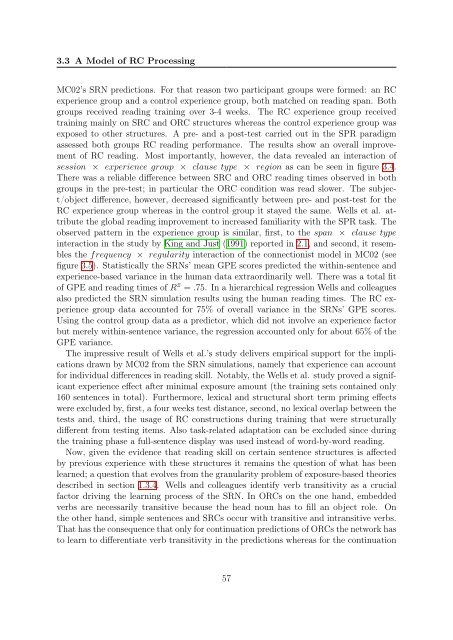Connectionist Modeling of Experience-based Effects in Sentence ...
Connectionist Modeling of Experience-based Effects in Sentence ...
Connectionist Modeling of Experience-based Effects in Sentence ...
You also want an ePaper? Increase the reach of your titles
YUMPU automatically turns print PDFs into web optimized ePapers that Google loves.
3.3 A Model <strong>of</strong> RC Process<strong>in</strong>g<br />
MC02’s SRN predictions. For that reason two participant groups were formed: an RC<br />
experience group and a control experience group, both matched on read<strong>in</strong>g span. Both<br />
groups received read<strong>in</strong>g tra<strong>in</strong><strong>in</strong>g over 3-4 weeks. The RC experience group received<br />
tra<strong>in</strong><strong>in</strong>g ma<strong>in</strong>ly on SRC and ORC structures whereas the control experience group was<br />
exposed to other structures. A pre- and a post-test carried out <strong>in</strong> the SPR paradigm<br />
assessed both groups RC read<strong>in</strong>g performance. The results show an overall improvement<br />
<strong>of</strong> RC read<strong>in</strong>g. Most importantly, however, the data revealed an <strong>in</strong>teraction <strong>of</strong><br />
session × experience group × clause type × region as can be seen <strong>in</strong> figure 3.4.<br />
There was a reliable difference between SRC and ORC read<strong>in</strong>g times observed <strong>in</strong> both<br />
groups <strong>in</strong> the pre-test; <strong>in</strong> particular the ORC condition was read slower. The subject/object<br />
difference, however, decreased significantly between pre- and post-test for the<br />
RC experience group whereas <strong>in</strong> the control group it stayed the same. Wells et al. attribute<br />
the global read<strong>in</strong>g improvement to <strong>in</strong>creased familiarity with the SPR task. The<br />
observed pattern <strong>in</strong> the experience group is similar, first, to the span × clause type<br />
<strong>in</strong>teraction <strong>in</strong> the study by K<strong>in</strong>g and Just (1991) reported <strong>in</strong> 2.1, and second, it resembles<br />
the frequency × regularity <strong>in</strong>teraction <strong>of</strong> the connectionist model <strong>in</strong> MC02 (see<br />
figure 3.5). Statistically the SRNs’ mean GPE scores predicted the with<strong>in</strong>-sentence and<br />
experience-<strong>based</strong> variance <strong>in</strong> the human data extraord<strong>in</strong>arily well. There was a total fit<br />
<strong>of</strong> GPE and read<strong>in</strong>g times <strong>of</strong> R 2 = .75. In a hierarchical regression Wells and colleagues<br />
also predicted the SRN simulation results us<strong>in</strong>g the human read<strong>in</strong>g times. The RC experience<br />
group data accounted for 75% <strong>of</strong> overall variance <strong>in</strong> the SRNs’ GPE scores.<br />
Us<strong>in</strong>g the control group data as a predictor, which did not <strong>in</strong>volve an experience factor<br />
but merely with<strong>in</strong>-sentence variance, the regression accounted only for about 65% <strong>of</strong> the<br />
GPE variance.<br />
The impressive result <strong>of</strong> Wells et al.’s study delivers empirical support for the implications<br />
drawn by MC02 from the SRN simulations, namely that experience can account<br />
for <strong>in</strong>dividual differences <strong>in</strong> read<strong>in</strong>g skill. Notably, the Wells et al. study proved a significant<br />
experience effect after m<strong>in</strong>imal exposure amount (the tra<strong>in</strong><strong>in</strong>g sets conta<strong>in</strong>ed only<br />
160 sentences <strong>in</strong> total). Furthermore, lexical and structural short term prim<strong>in</strong>g effects<br />
were excluded by, first, a four weeks test distance, second, no lexical overlap between the<br />
tests and, third, the usage <strong>of</strong> RC constructions dur<strong>in</strong>g tra<strong>in</strong><strong>in</strong>g that were structurally<br />
different from test<strong>in</strong>g items. Also task-related adaptation can be excluded s<strong>in</strong>ce dur<strong>in</strong>g<br />
the tra<strong>in</strong><strong>in</strong>g phase a full-sentence display was used <strong>in</strong>stead <strong>of</strong> word-by-word read<strong>in</strong>g.<br />
Now, given the evidence that read<strong>in</strong>g skill on certa<strong>in</strong> sentence structures is affected<br />
by previous experience with these structures it rema<strong>in</strong>s the question <strong>of</strong> what has been<br />
learned; a question that evolves from the granularity problem <strong>of</strong> exposure-<strong>based</strong> theories<br />
described <strong>in</strong> section 1.3.4. Wells and colleagues identify verb transitivity as a crucial<br />
factor driv<strong>in</strong>g the learn<strong>in</strong>g process <strong>of</strong> the SRN. In ORCs on the one hand, embedded<br />
verbs are necessarily transitive because the head noun has to fill an object role. On<br />
the other hand, simple sentences and SRCs occur with transitive and <strong>in</strong>transitive verbs.<br />
That has the consequence that only for cont<strong>in</strong>uation predictions <strong>of</strong> ORCs the network has<br />
to learn to differentiate verb transitivity <strong>in</strong> the predictions whereas for the cont<strong>in</strong>uation<br />
57
















